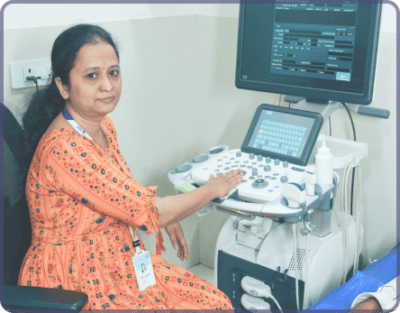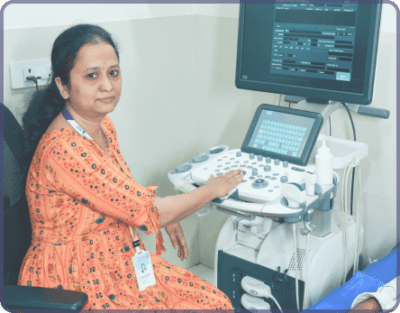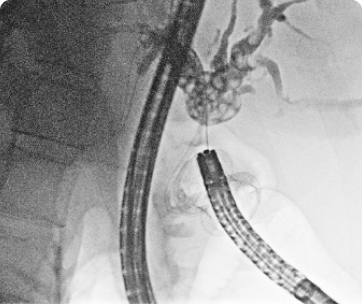EUS (ENDOSCOPIC ULTRASOUND)
Endoscopic Ultrasound (EUS) is a medical procedure that uses an endoscope equipped with an ultrasound probe to obtain detailed images of the digestive tract and surrounding organs.

EUS (ENDOSCOPIC ULTRASOUND)

Endoscopic Ultrasound (EUS) is a medical procedure that uses an endoscope equipped with an ultrasound probe to obtain detailed images of the digestive tract and surrounding organs.
EUS is endoscopic ultrasonography. An ultrasound probe is incorporated into a standard upper GI endoscope. The usual upper GI endoscope helps the doctor to see only within the cavity of the esophagus, stomach, and 1st part of the small intestine(duodenum); incorporating an ultrasound probe helps the doctor to see organs around the parts mentioned above of the patient’s gut like heart, mediastinum, liver, pancreas and bile and pancreatic ducts.
1,11,1000+ CASES HANDLED
3 HI-TECH ENDOSCOPY DEVICES
5+ SPECIALIST GI ENDOSCOPIST
The patient should be fasting for 6-8 hours before the procedure
Cardiologist or physical fitness is taken. Procedure is done under sedation or under short general anesthesia
Diagnostic EUS
Small bile duct stones missed on sonography/CT/MRI
Early chronic pancreatitis
Bile duct or pancreatic cancers and take a biopsy for diagnosis
Lymph nodes in the chest for biopsy
Diagnosis of the early stomach and duodenal cancers and depth of invasion
Therapeutic EUS
EUS Guided gastro cystostomy (drainage of pancreas collection/abscess)
EUS-guided pseudoaneurysm coil embolization (bleeding through abnormal vessel)
EUS-guided gastric variceal coil glue embolization
EUS-guided Biliary drainage: after failed ERCP or altered anatomy due to previous surgery or cancers
EUS-guided gastroenteric or enteroenteric anastomosis (connecting the stomach to the small intestine or small to the large intestine in obstruction due to cancers)
Patients should be fasting for six hours. IV antibiotics may be given.
Antiplatelets or anticoagulants (blood thinners) should be stopped as per physician or cardiologist advice for 2-7 days before the procedure.
The patient may experience bloating, mild pain, or vomiting post-procedure; other complications are:
Bleeding
Perforation (hole in the intestine)
The patient should be fasting for 6-8 hours before the procedure
Cardiologist or physical fitness is taken. Procedure is done under sedation or under short general anesthesia
Diagnostic EUS
Small bile duct stones missed on sonography/CT/MRI
Early chronic pancreatitis
Bile duct or pancreatic cancers and take a biopsy for diagnosis
Lymph nodes in the chest for biopsy
Diagnosis of the early stomach and duodenal cancers and depth of invasion
Therapeutic EUS
EUS Guided gastro cystostomy (drainage of pancreas collection/abscess)
EUS-guided pseudoaneurysm coil embolization (bleeding through abnormal vessel)
EUS-guided gastric variceal coil glue embolization
EUS-guided Biliary drainage: after failed ERCP or altered anatomy due to previous surgery or cancers
EUS-guided gastroenteric or enteroenteric anastomosis (connecting the stomach to the small intestine or small to the large intestine in obstruction due to cancers)
Patients should be fasting for six hours. IV antibiotics may be given.
Antiplatelets or anticoagulants (blood thinners) should be stopped as per physician or cardiologist advice for 2-7 days before the procedure.
The patient may experience bloating, mild pain, or vomiting post-procedure; other complications are:
Bleeding
Perforation (hole in the intestine)

PROCEDURES WE CONDUCT
FREQUENTLY ASKED QUESTIONS
FREQUENTLY ASKED QUESTIONS
Don’t wait!!
Get consulted with our GI specialist today
Book your appointment effortlessly.
ANTRANG KNOWLEDGE RESOURCE
ANTRANG KNOWLEDGE RESOURCE
get in touch
We are just a phone call away when you need us!









